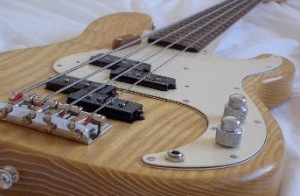Kill That Dead Spot
 There’s a funny thing that happens with some basses. It’s called the dead spot.
There’s a funny thing that happens with some basses. It’s called the dead spot.
What’s A Dead Spot?
The dead spot is a particular note that won’t seem to ‘ring’. It won’t sustain and instead, the fundamental just dies away almost immediately. Sometimes you’ll hear some overtone-type vibrations of the note sustain very faintly but for the most part, the note is gone.
This tends to be most noticeable on one particular string and on one particular note but it can be evident (possibly to a lesser extent) a half-tone higher or lower and with the same note(s) on different strings.
The dead spot can, theoretically, occur on guitars too but it tends to make itself known on basses. Also, although not exclusively, it tends to make itself known primarily on Fender basses.
It’s possible to confuse a dead spot with a note that gets choked by a high/low fret but it’s a different beast entirely.
What Causes A Dead Spot?
To go into detail about this is beyond the scope of this article and beyond the scope of stuff I can bluff my way through.
In basic terms though, any note you play on your bass is the result of the string vibrating at a particular frequency. With me so far?
You’ve probably experienced sympathetic vibration when you’ve played. This might have manifested itself as the drummer’s snare vibrating when you play a certain note or your mum’s fine china rattling on the shelf every time you play an open ‘A’. These things happened to resonate in sympathy with a particular note.
Sometimes, a bass guitar resonates in sympathy with a particular note too and, sometimes, that resonance happens to work against the note being played with the result that that note’s vibration is quashed. You hear it as a quickly dying note or a dead spot.
Bummer.
So How Do I Cure A Dead Spot?
It’s all about changing the way the bass resonates. While I can’t, unfortunately, give you a definitive guide to fixing your dead spot, I can let you have a couple of tips. Your own mileage may vary and one or all may not work. One or both have worked for me in the past so… good luck.
1. Alter the resonance with cash
Groove Tubes make a device called the Fat Finger. This is a relatively chunky piece of chrome-plated brass (the same as that used to make bells, apparently) that is designed to clamp onto your bass headstock. It attaches without permanently altering the instrument so you can remove it at any stage in the future.
The increased mass at the end of the neck alters how it vibrates and may be sufficient to change the frequency at which your dead spot occurs. All going well, it will be shifted to some frequency between those that make up the notes of the western scales we’re used to. If you don’t get the result you want, try moving it about the headstock – different placement gives different results.
There are claims that the Fat Finder can increase sustain and improve tone. As to the former, I’d say it does make a small difference but the tone claim is probably a little more subjective.
Some don’t care for hanging a hunk of metal from their headstocks and doing so certainly alters the balance of the instrument. For these people the following may help.
2. Alter the resonance for free
So, this time around what we’re going to do is to partially decouple the bass’ neck and body.
As a little background, once while trying to track down a dead spot, I did all manner of things to improve the couple between the body and neck with the result that everything I did made things worse. After chasing my tail for a long time, it occurred to me that I was on the wrong track.
I tried backing out the screws that secure the neck to the body and immediately saw a difference. What I’d done was to alter, slightly, the way in which the neck and body vibrated as one.
I have to stress that you’re not loosening these screws by much – the smallest fraction of a turn. The last thing you want is a neck that wobbles about in its pocket but, a tiny amount (an eight of a turn or even less) seems capable of making a difference.
Purists will argue tone and sustain with me and, while they’re probably right in theory, in practice, I haven’t been able to detect a difference. The amount of loosening is not sufficient to cause an audible difference in my experience and opinion.
What it has done though, again in my experience, is shift the dead spot sufficiently that it’s cured or very much improved.
Out Of The Dead Zone
As I say, there are no guarantees with this one. Both of these solutions are things that you can try yourself for little or no outlay and both are completely reversible.
Worth a try.
Newsletter
[mc4wp_form]

